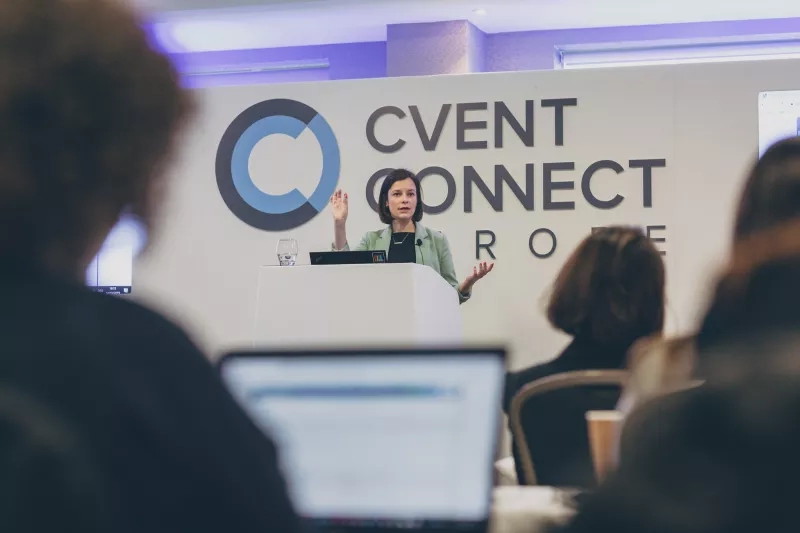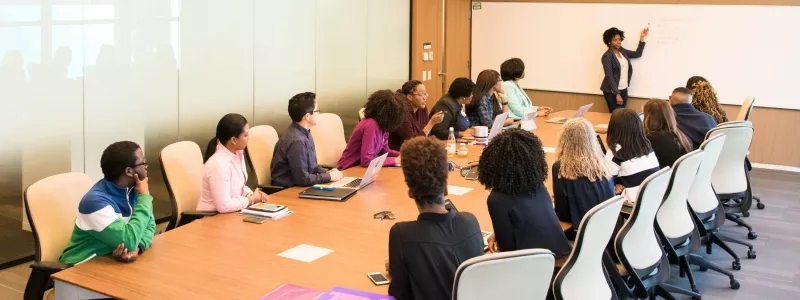How often, after leaving an hour-long meeting, have you heard someone say, “that could have been an email?” Employees don’t like having their time wasted. With a finite number of hours in a day and too much work to be done, meetings that don’t make an impact leave employees with increased levels of stress and irritation. The fact of the matter is, no one wants to sit through a meeting where nothing gets accomplished. But meetings aren’t all bad. Face-to-face interaction fosters creativity, supports cooperation, and can get teams to reach solutions that never would have been reached individually. Meetings spend represents just over 1% of overall revenue for most corporations. So, how do you plan an effective meeting?
What is a Meeting
A meeting occurs when two or more people gather. Meetings are everywhere in the working world. Unlike a trade show or a teambuilding activity, a meeting is a general term that can be used to describe any time people get together. What makes something a meeting versus an event? Meetings and events are like rectangles and squares. Where all events are meetings, not all meetings are events. Meetings tend to be held for educational or business purposes, where events can range in scale and purpose. Where a basketball game could be considered an event, it is not a meeting.
What is a Virtual Meeting?
Another type of meeting, a virtual meeting, takes place online. These meetings have greater accessibility and are lower in cost, if you have a virtual event solution. When considering whether to host an in-person meeting, a virtual meeting, or a hybrid meeting, think about your audience. Are they spread across the globe? Do you have budget constraints? Virtual meetings tend to have higher registration numbers than in-person meetings as the level of commitment for attendees (no travel, little time away from the office, no cost of a hotel) is less.
The Purpose of Meetings
Meetings are held to communicate something, for a business or educational purpose. There could be a new initiative, a project update, or HR training. A meeting is held when the most efficient way to reach a common goal is to gather, whether virtually or in person.
Common Reasons to Hold a Meeting
- Announce a new initiative or organizational change
- To collaborate and create something new
- To address challenges and figure out how to solve them
- Kick off a project
- Clarify or set expectations
Types of Meetings
Meetings can serve many purposes. The most common meeting purposes are to: educate, team build, inspire, solve problems, and consult.
Educational Meetings
These meetings require the speaker to be engaging and provide clear material. Educational meetings can range from an HR training on company policy to a rundown of a new product. While there is little interaction in these meanings, information retention is key, and it can help to provide a quick or summary document after the meeting for attendees to reference.
Team Building Meetings
These meetings aim to bond colleagues and bolster work culture. A team that respects one another and gets along will work together better. Team building meetings can be thought of as a waste of time because their purpose is not as aligned to company initiatives as other types of meetings, but they are anything but that. They engage employees and lead to higher rates of retention. To avoid grumbling, set a clear goal or expectation before the meeting and make sure the team building activity is relevant to the team.
Inspirational Meetings
Sometimes the sales team needs a little pep talk. Sometimes marketing needs to be inspired by a leader in the industry. Inspirational meetings are held to cultivate bursts of energy and engage employees who might be in a slump. Try to make these meetings more interactive.
Problem-Solving Meetings
Most meetings fall in the problem-solving category. There may be a bug to fix, a project to orchestrate, or team dynamic to address. Problem-solving meetings should start with background information and articulate what needs to be accomplished by the end of the meeting.
Consultative Meetings
These meetings are sent to get the opinion or input of an expert. Consultative meetings involve more Q&A than other types and can help make sure that a project is on the right track. These meetings can also provide updates and look to others for feedback.
External versus Internal Meetings
An organization’s events program is built of the meetings they host, ones they attend, and internal events. 90% of meeting & event professionals plan internal and external events (Internal Events by the Numbers). Both external and internal meetings can be educational, team building, inspirational, problem-solving, or consultative. So, what is the difference between these two types of meetings?
External Meetings
An external meeting is one held for individuals outside of your organization. These meetings can involve clients and prospects, as well as employees. The primary goal of these events varies, but can be used to gain leads and increase sales pipeline. These meetings are can more easily be proven successful, as they rely on data related to leads and sales pipeline.
Internal Meetings
Internal events are events held within the organization for employees. They can be for a small team or for an entire organization and can occur once a year or more than ten times a year. There is a tremendous variety in the types of internal events an organization can host. All of these events make up your internal event program. Internal events are part of an organization’s overall events program and their primary goal to keep employees engaged, motivated, and loyal. are the lifeblood of an organization, and when employees feel valued, they work harder and stay longer. Engagement determines whether employees will stay for twenty years or if they’ll turn in a letter of resignation.
Planning an Effective Meeting
Not all meetings are effective. Start on the right foot by following a few easy steps. All meetings can be effective. Everyone is busy and has a million projects, the time you set aside for meetings should make an impact.
Easy Ways to Make a Meeting Effective
- Start on time
- Provide a purpose or agenda for the meeting.
- Allow participants to ask questions.
- Talk clearly – not in circles.
- Provide a location for the meeting or provide a way to join a virtual meeting.
- End the meeting with clear action items that identify a person to take on the task and a due date.
- Provide background information early so that attendees come to the meeting prepared – no one wants to waste time on a lengthy recap.
- Have everyone take notes but assign a clear note taker. Watch for gender bias - Women are routinely asked to take meetings notes over men, in an unfair division of “office work” according to Forbes.
- Make the agenda manageable. Don’t have ten items to discuss in a 30-minute meeting – it won’t happen and something urgent may be left on the table.
- Make meetings interactive and keep participants engaged.
- Accommodate special needs.
- Set realistic time frames to complete action items and tasks.
What Makes Up A Meeting
Meeting Owner
The meeting owner is the individual in charge of running the meeting and keeping the group on track. While a meeting owner can be the planner of the meeting, for larger meetings this isn’t always the case. If a meeting planner is required to plan the meeting, then there will still be a meeting owner or POC who will be giving direction and guidance on what they need.
Attendees
Who will be in the meeting? When deciding who should be invited to a meeting, think through the meeting purpose. Is there someone that should be included that could provide insight or guidance? Meetings seek to achieve something, but without the right people in the room, they often don’t meet their goals. As you build your participant list, think through who would be most beneficial in the room. But, make sure you aren’t adding individuals who aren’t involved in the topic or who don’t belong.
Time and Location
For a small meeting, it’s easy to use the features of a work calendar to check the schedules of others to pick a time that works best for the group as a whole. Pay attention to different time zones. In terms of location, never fail to include one. While scheduling a room to foster face-to-face interaction for employees in the office, virtual meeting options can provide greater flexibility and accessibility. If it’s standard practice to include a call-in number or code for your meeting, don’t forget to include it in the meeting invite. For larger meetings that need a venue outside of the office, look to venue sourcing tools to find the right space to fit your needs.
Meeting Invites and Registration
The invite might be a calendar invitation or a registration using event technology tools. The invite is key to getting people at your meeting and should be sent out well in advance. In the meeting invite or registration site, include the purpose of the meeting and the agenda, if it exists, as well as any background information essential to the meeting.
Content
Content can be the slide deck, visuals, a list of questions, or the speaker for the meeting itself. If this meeting involves an external speaker, then they are the content. This content drives the meeting, which is why it’s necessary to take the time to prepare. What is the meeting about? The answer will drive the content.
Meeting Technology
This is the screens, the computers, the speakers, the microphones, the phones, the sharing tools, the messaging system, video conferencing system, and more that make a meeting run. Understanding how the technology works in a meeting room or what will be available offsite keeps meetings running smoothly and cuts down on wasted time.
Meeting Follow-up
The last piece of the meeting is the follow-up. This includes a recording of the meeting, if one was made, the notes, and the action items with the item owner and deadlines identified.
Meeting Planning
Regardless of the size of the meeting, there is a basic process to follow when planning.
Meeting planning template
- Define the meeting purpose and identify meeting type.
- Determine the meeting size. This will affect the location.
- Determine the meeting duration. Does it take place over lunch? You may need to provide food.
- Identify a budget. If this is a normal, everyday meeting, you won’t have to do this. But, if this meeting is for a larger group and being held off-site, always start by understanding the standard budgetary requirements for organizational meetings.
- Find a location. Book a meeting room or set a location in the office. Does this meeting need to take place offsite? Source a venue.
- Build an attendee list based. Identify if any participants are optional.
- Pay attention to time zones when scheduling your meeting. Pick a time that works for all participants.
- Build the agenda – at least summarize the meeting purpose to include in the meeting invite.
- Send out the meeting invite. Calendar invites can be used for meetings of all sizes, but for large meetings consider using a registration tool to better track RSVPs.
- Book travel and hotel accommodations when necessary.
- If your agenda was incomplete, update the invite it and resend it to attendees.
- Gather content – presentation, visuals, etc. – for the meeting.
- Execute the meeting.
Meeting Agenda
All meetings should have some form of agenda. This can be a short sentence explaining the purpose or a detailed, minute-to-minute breakdown of topics for discussion. There
Meeting Agenda Example
Meeting purpose: Purpose of the meeting, meeting KPIs, and goals.
- Agenda Item 1
- Description
- Agenda Item 2
- Description
- Agenda Item 3
- Description
Review and Assign Action Items
Background information and supporting documents
After the Meeting
Now is the time to send out the notes from the meeting as well as action items with owners and deadlines. If this was a larger meeting, consider sending a survey to gauge the success of the meeting and find out if there are ways to improve in the future. Meeting success will look different from meeting to meeting but take time to review the initial goals and evaluate whether those goals were met or if a plan was put in place to meet the goals. If this was a larger meeting, use surveys to measure success.
Benefits of a Standardized Meeting Process
If your organization has a large number of meetings that require finding venues, coordinating travel, and managing food and beverage across many offices, it might be useful to look into standardizing your meeting process. Standardizing a meeting program can allow you to track meeting activity, automate sourcing and budgeting to save time, and increase compliance and efficiency with standard processes. Check out Strategic Meetings Management Dummies Book for more information.
Create a Meetings Policy
Every well-written policy includes a clearly defined scope that dictates who is required to comply, what types of meetings are included, where and when the policy applies (geographically and/or organizationally). It is also important to clearly state any policy exceptions or what is considered out-of-scope.
For a meetings policy, you’ll need to clearly define the following
1. Definition of a Meeting
2. Sourcing and Planning Procedures
4. Roles and Responsibilities
5. Regulatory Risk Management
6. Duty-of-Care Guidelines
7. Fiduciary Risk Management and Spending Guidelines
8. Meeting Requests and Approvals
9. Health and Emergencies
10. Group Air Travel
11. Booking Accommodations
12. Familiarization Trips and Loyalty Programs
13. Site Inspections
14. Budget Approval and Payment Processes
15. Companion and Personal Travel
16. Virtual Meetings
17. Social Responsibility and Green Policy
18. Tax Implications
For a more detailed template, check out our Meeting Policy Template.
Plan a Meeting That Makes an Impact
In the end, planning an effective meeting comes down to preparation, organization, and respect. Take the time to understand why you want to hold a meeting, don’t just create one for the heck of it. Meetings have the power to bring out new ideas, identify solutions to tough problems, address issues, build camaraderie, and more. When planning, stay organized. Provide background information, an agenda, and start the meeting on time. In the end, it’s about respecting the people you work with. When you give them the tools to succeed and make the most of their time, the meeting will make an impact. Meetings occur every day. Why not make your next one better than ever?










